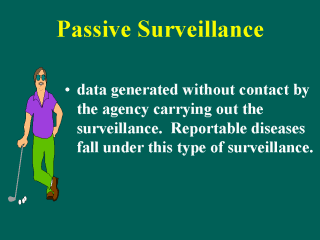| front |1 |2 |3 |4 |5 |6 |7 |8 |9 |10 |11 |12 |13 |14 |15 |16 |17 |18 |19 |20 |21 |22 |23 |24 |25 |26 |27 |28 |29 |30 |31 |32 |33 |34 |35 |36 |37 |38 |39 |40 |41 |42 |43 |review |
 |
More commonly
surveillance systems are passive. By definition, researchers or health
department personnel do not go out into the community to find cases. Rather,
they develop instruments that persons in the community have to send into
them (e.g. death certificates) as a means of identifying events. Reportable
diseases such as AIDS and malaria, etc. are monitored in this fashion.
Laboratories, physicians, and hospitals have to report these events to the health department when they identify a case at their institution. In some states, spinal cord injuries are a reportable condition and are followed with passive surveillance. |